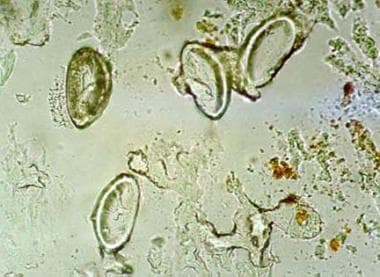Author
Sun Huh, MD, PhD Chairman, Professor, Department of Parasitology, College of Medicine, Hallym University, Republic of Korea
Disclosure: Nothing to disclose.
Chief Editor
Michael Stuart Bronze, MD David Ross Boyd Professor and Chairman, Department of Medicine, Stewart G Wolf Endowed Chair in Internal Medicine, Department of Medicine, University of Oklahoma Health Science Center; Master of the American College of Physicians; Fellow, Infectious Diseases Society of America; Fellow of the Royal College of Physicians, London
Michael Stuart Bronze, MD is a member of the following medical societies: Alpha Omega Alpha, American College of Physicians, American Medical Association, Association of Professors of Medicine, Infectious Diseases Society of America, Oklahoma State Medical Association, Southern Society for Clinical Investigation
Disclosure: Nothing to disclose.
Additional Contributors
Soo-Ung Lee, PhD Manager, Research and Development, Chuncheon Bioindustry Foundation, Korea
Disclosure: Nothing to disclose.
Acknowledgements
Joseph J Bocka, MD Director of Shelby Emergency Department, Attending Emergency Physician at Mansfield Hospital, Med Central Health System (Mansfield and Shelby, Ohio); Emergency Medical Service Medical Director for several services
Joseph J Bocka, MD is a member of the following medical societies: American Academy of Emergency Medicine, American College of Emergency Physicians, American Medical Association, National Association of EMS Physicians, and Phi Beta Kappa
Disclosure: Nothing to disclose.
Pamela L Dyne, MD Professor of Clinical Medicine/Emergency Medicine, University of California, Los Angeles, David Geffen School of Medicine; Attending Physician, Department of Emergency Medicine, Olive View-UCLA Medical Center
Pamela L Dyne, MD is a member of the following medical societies: American Academy of Emergency Medicine, American College of Emergency Physicians, and Society for Academic Emergency Medicine
Disclosure: Nothing to disclose
Mary D Nettleman, MD, MS, MACP Professor and Chair, Department of Medicine, Michigan State University College of Human Medicine
Mary D Nettleman, MD, MS, MACP is a member of the following medical societies: American College of Physicians, Association of Professors of Medicine, Central Society for Clinical Research, Infectious Diseases Society of America, and Society of General Internal Medicine
Disclosure: Nothing to disclose.
David A Peak, MD Assistant Residency Director of Harvard Affiliated Emergency Medicine Residency, Attending Physician, Massachusetts General Hospital; Consulting Staff, Department of Hyperbaric Medicine, Massachusetts Eye and Ear Infirmary
David A Peak, MD is a member of the following medical societies: American College of Emergency Physicians, American Medical Association, Society for Academic Emergency Medicine, and Undersea and Hyperbaric Medical Society
Disclosure: Nothing to disclose.
Francisco Talavera, PharmD, PhD Adjunct Assistant Professor, University of Nebraska Medical Center College of Pharmacy; Editor-in-Chief, Medscape Drug Reference
Disclosure: Medscape Salary Employment
Jeter (Jay) Pritchard Taylor III, MD Compliance Officer, Attending Physician, Emergency Medicine Residency, Department of Emergency Medicine, Palmetto Health Richland, University of South Carolina School of Medicine; Medical Director, Department of Emergency Medicine, Palmetto Health Baptist
Jeter (Jay) Pritchard Taylor III, MD is a member of the following medical societies: American Academy of Emergency Medicine, American College of Emergency Physicians, American Medical Association, and Society for Academic Emergency Medicine
Disclosure: Nothing to disclose.
Gordon L Woods, MD Consulting Staff, Department of Internal Medicine, University Medical Center
Gordon L Woods, MD is a member of the following medical societies: Society of General Internal Medicine
Disclosure: Nothing to disclose.






